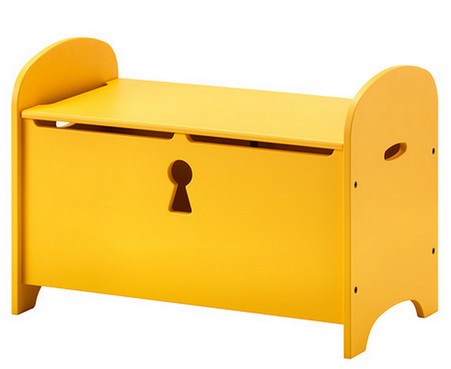Before you organize the storage of toys in the nursery, you need, first of all, to get rid of unnecessary - those in which children no longer play by virtue of age, who broke down, or just became not interested. To how to store children's books, it is worth approaching more reverently.
Firstly, what is not interesting now, it will be able to interest in the future. Secondly, in our century of general "gadgetization" printed publications are gradually becoming a rarity, and throwing out many of them would be extremely unreasonable.
Where and how to properly store toys in the nursery
How to properly store toys in the nursery, so it was convenient for the child and parents? Try to arrange them so that the child sees them all and can independently take them from shelves or from boxes. Option, when all toys are dumped together by a common heap in a drawer or basket (also opaque), does not fit. The child will play either only those toys that are on top, or each time pour out the entire contents of the basket on the floor and then do not know with what of all this wealth to play. Both options do not suit us.
A very common problem faced by mothers and children after a successful "scrapping" and systematization of things in the children's room is inconvenience. Storage of toys in the nursery is organized so that when the child wants to get something, he has to dump everything on the floor, after which he has no interest in raising it and putting it in place, because he did not come to this shelf for this, but for in order to get what he needs. The easiest way out is to organize the storage of toys in the nursery in such a way that the child does not have to drag on, move something aside, move, that is, arrange them in one row.
As you can see in the photo, "one-dimensional" storage of toys in the nursery is the most optimal option:
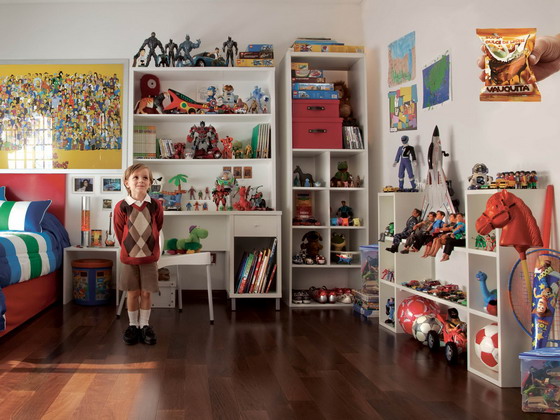

If you know that a child often plays with toys or games, place them as close as possible, as low as possible on the shelves, so that the child can take them without making any additional effort that can lead to confusion.

What the child plays rarely, we remove higher. But if you want to organize the storage of toys in the children's room in such a way as to make these unpopular objects accentuate, it's not enough to just leave them in sight. You need to most often offer them, include in your favorite games the child with other items, and also periodically rearrange them to low shelves so that the child notices them, and thus stimulate his interest in these games and toys.
Variants, how to organize the storage of toys in the nursery and other rooms
Sometimes, moms complain that the house looked like a group of kindergartens - everywhere toys: in the kitchen, in the corridor, in the parent's bedroom ... In fact, there is nothing terrible in this, and this is not a sign of a mess in your apartment. Where to store children's toys, if during the day you often move with your child from one room to another, doing your household chores? It is very useful in each of these rooms to have a children's playground, where you place toys and books that will entice the child while you are busy. This is a very practical option, which should be used while the child is too young to play alone.

In order for this conscious step not to lead you to a mess, you need to systematize these toys and books and find a convenient place for their storage in each room. How to store children's toys in rooms not intended for this? Let it be a part or a small box, a basket or a bag, under a chair or on a windowsill, depending on what you can afford in each particular room. Be sure to select a piece of space that will be officially fixed for storing and finding children's things there. Secure this place behind these things, and let them be there. Here it is important to establish a rule - for themselves and for the child - that these toys will be located right here.
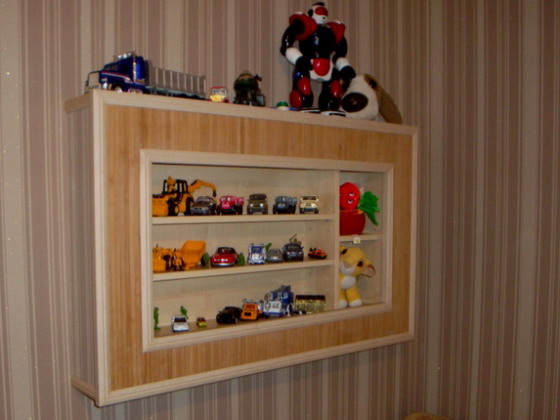
A great idea for storing toys in the "branch" of the children's room is to fix such premises in separate areas of the child's development. For example, arrange all the materials for creativity in the kitchen, if it is there that you find it more convenient to do creativity with the child. If you know that here you only have such toys, and you do not drag them from one room to another, then the natural dispersal of children's toys throughout the apartment will not bring any difficulties when cleaning.
Such options for storing toys in the children's corners of different rooms will allow to carry away the child in any room.
How can I get rid of toys?
Spend a little time, call to the aid of common sense and get rid of unnecessary toys, if you have not already done so. It may be incomplete puzzles and lotto, broken toys or those that you simply do not like or into which the child does not play at all, toys from which the child has grown or to which it will not grow very soon, the same type, etc.
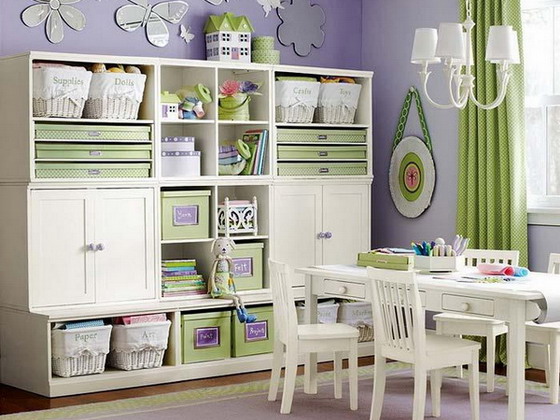
How can I get rid of toys so that there are as few unnecessary objects in the room as possible? You can get rid of differently - broken and spoiled, of course, it's worth throwing away, putting toys into a box or a package, inscribing it on the prospective age suitable for the game and putting it away, toys of the same type can be sold, sold or exchanged by posting ads in Internet or on the bulletin board near the playground where you usually walk.
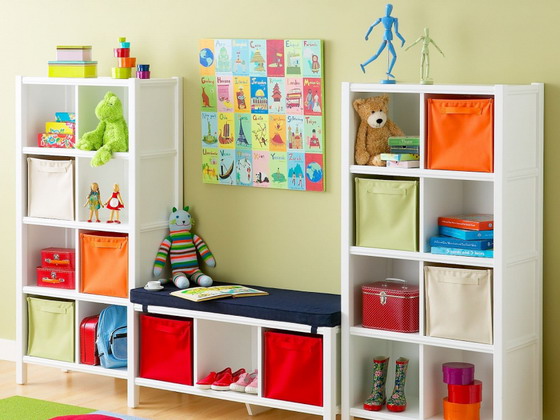
The remaining toys, if there are many of them, can be divided into 2 - 3 sets for organizing the circulation of toys. Change toys from these sets about once a week (orient on the child: if you see that he is still very enthusiastically playing with something after a week, you can and wait with the replacement of this toy).
Where and how to store children's books
Today, when every day there are more and more books for children and children. Therefore, the issue of keeping books in the children's room and their systematization is quite acute. The most effective and cardinal decision that you can take in order to take control of the filling of the children's room with books is to enroll in the children's library. This is especially true and beneficial, if new books are published regularly in your library. In this case, you get the opportunity not only to save considerably on buying books, but also to prevent the appearance of an excessive number of books in the children's room.
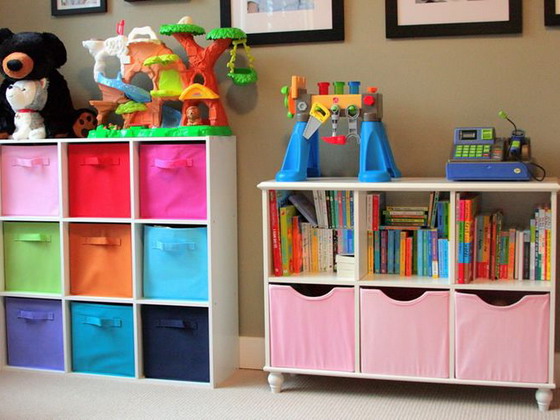
If there are any difficulties with the recording in the library, for example, the library is far away or does not suit you by some other parameters, unite with the other mummies of the children of your children's age for the exchange of books (and also toys, board games, etc.) . Surely the children's libraries of each of you will be different by at least a few titles of books. Thus, you kill two birds with one stone: you spend less on purchasing and you can read more interesting books with your child. If you have familiar mothers with whom you communicate closely and are ready to exchange toys and books with them, try to initiate such an exchange. Many mothers will gladly support your initiative and say "thank you" for this.
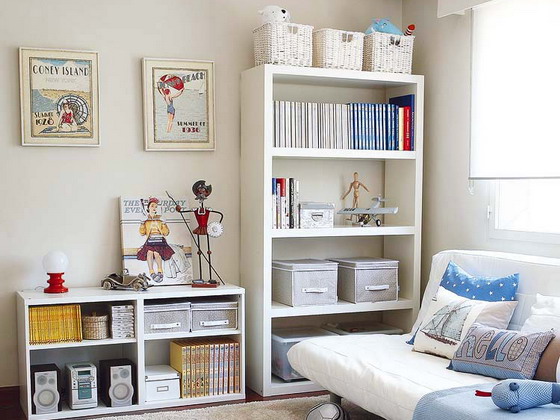
When deciding on expanding the space for books in the children's room, try to systematize the books for the convenience of their use by the child. Where to store children's books so that the necessary ones are always at hand? Like toys, books that you read to the child or that he reads (or considers) on his own, it is absolutely necessary to locate the child in the access zone.

It will be just perfect if the child sees the cover of the book, not just its spine. Of course, it is difficult to put all the books in this way, but you can attract the child's attention to those publications that you consider useful, interesting, suitable for the topic of your studies. The exception is books with thin pages for children under 1.5 years old and especially valuable books that you would like to read to your grandchildren after years. Keeping these books in the nursery should be arranged in such a way as to be located away from the little fingers, but so that the child can see them and tell you about their desire to honor them.
Look at the photo "Storage of toys and books in the children's room", perhaps some ideas will please you:


How many toys should a child have
If your child is more than 1.5 years old, most likely, you already know firsthand what "many toys" means. Before you look for ideas for storing toys in a nursery, answer yourself the following questions. How do you buy baby toys? Often or rarely? Just like that or just about? Choose a long and carefully or grab the first one? Do you give the right to choose a child or always leave the last word? Thanks to the efforts of marketers today almost every parent "does not belong to himself" in the matter of choosing and buying toys.
Most often parents show immodesty in this matter, because "reasons" to buy a child a toy is very much:
- stayed at work - bought a toy,
- the kid behaved well - they bought a toy,
- the kid behaved badly - promised to buy a toy.
And once promised, you need to perform, otherwise the next time the reception does not work.
If parents do not buy toys at the first request of the child and somehow restrain their own impulses, a feeling of guilt becomes a frequent guest in their soul - your child does not have the same toys (like the same ones as his sandbox companions) you spend so much time at work, the child is neglected, and you can not even buy a twenty-fifth machine for him, because - you know how ruthless we sometimes are to ourselves.

But if you consciously limit the flow of toys to your house or, rather, control it, the guilt recedes, and you get the opportunity to actually take care of your child's development and give him the best.
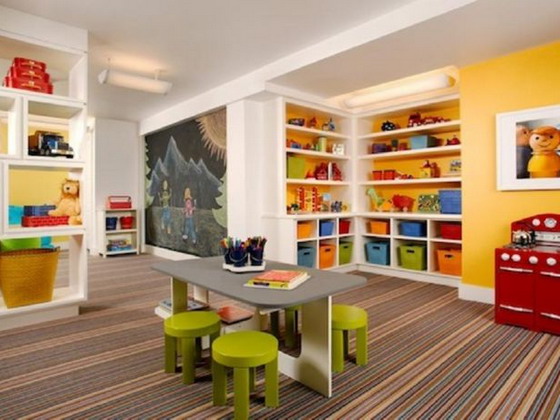
So how many toys should a child have for his normal development? A sufficient number of toys is determined not by the purchasing power of the parents, not by the size of your children's room and not even by the age of crumbs. There are enough toys if you, the parents, have enough of them to organize joint games with the child and his independent play.
How many toys does a child need: "less is better"
Thinking about how many toys a child needs, always follow the principle of "less is better". However, we all know that the same toys sooner or later can bore the kid (at least if his imagination does not turn on earlier than yours is over), so try to arrange a so-called "toy cycle" at home. This means that periodically you remove some toys from the child's field of vision (for example, take them out to the balcony or send them to the mezzanine), getting in return other, well-forgotten old ones.
There are a number of reasons why a large number of toys can be harmful to a child.

At first, many noticed that the more toys are simultaneously in the field of view of the child, the more difficult it is for him to choose one and start the game. If the child makes this difficult choice, he very seldom really enjoys playing, is constantly distracted and does not stay on one toy for more than a couple of minutes. In such conditions, the plot game, which is so important for the development of the child, can not develop.

Secondly, a large number of various toys, especially the so-called developing and interactive, limits the development of the child's creative abilities and fantasies and, as a consequence, makes the formation of the role-play difficult. If you buy a doll's head, a set of toy combs, scissors and shampoos to play with the child in the hairdresser, the child will find it difficult to play the driver with a ring from the pyramid and a stool as a props. To play with objects-prototypes (a toy set of the doctor, a doll's head, toy products, etc.) is easier. And playing with substitute items is more interesting and much more useful for the development of the child. But this is more difficult for parents, because such games need a child to teach. It's much easier to buy another "set for story-role games" - pink plates, acid-orange carrots, music and lighting effects in the kit.
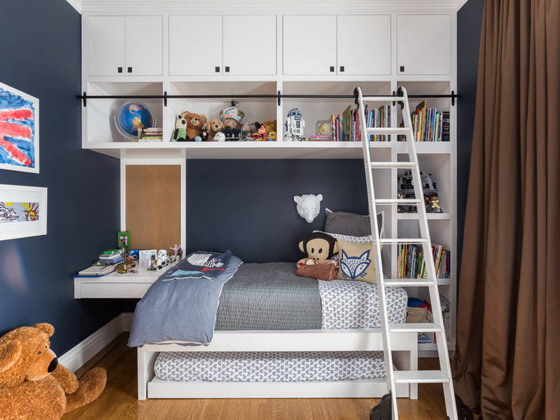
Thirdly, a child who regularly receives toys without any reason - with each arrival of relatives, with every return of parents from work, begins to perceive such gifts as a matter of course. And it's bad even that he is upset and actively expresses his displeasure, when for various reasons such traditions are violated. The bad thing is that in this case, the joy of meeting with loved ones and loved ones is replaced by the joy of a new toy. Just think: the child rejoices not you, not the opportunity to talk, embrace, play, do something with you, but only because you brought a new toy. It's sad and scary.
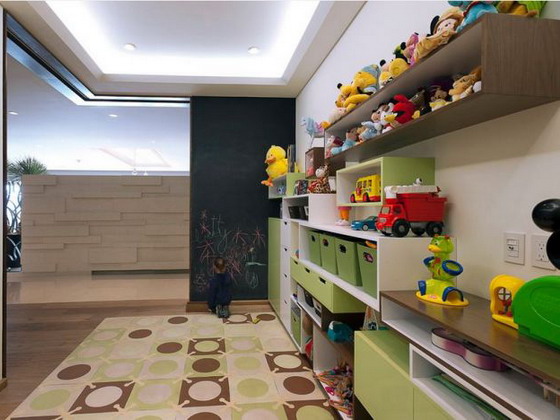
Fourthly, too many toys and too frequent their purchase interfere with the education of a respectful attitude towards them. Of course, if a child accidentally broke his favorite car or lost an expensive doll for him, any parent will find an opportunity to quickly buy another toy. But when such situations are repeated regularly, the child simply does not understand why it is necessary to appreciate toys. After all, instead of a torn book, my mother will buy another, and the place of a broken toy will quickly be replaced by a new one.

Fifthly, when new toys appear in the house too often, the child does not have time to become emotionally attached to the previous one, does not have time to play with it, to open all the possibilities of its use in the game. Often, and the parents themselves, seeing that the child does not approach a recently donated toy for a couple of days, go to the store for a new one, instead of showing the child other possibilities of an "old" toy or simply playing along with the child.
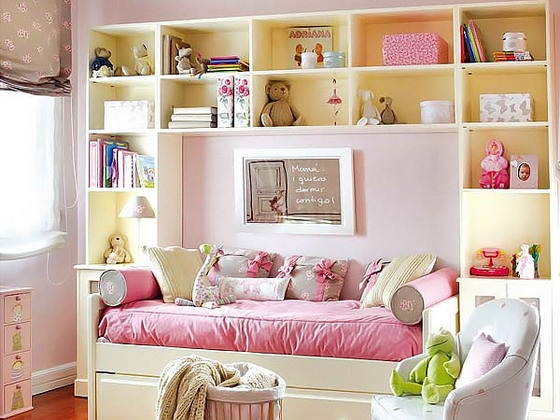
At sixth, a large number of toys - this is always a potential threat to order in the room. And the disorder in the room is a fertile ground for quarrels and conflicts, not to mention the attendant difficulties of teaching the child organizational skills.
What to do with the existing toys and how to take control of toys that are just going to take their place on the shelves in the nursery?
To take control of the flow of toys is not difficult, when you understand why this is done. The most difficult, perhaps, will be to negotiate with relatives, especially with grandmothers who are so fond of indulging their beloved granddaughters. Try to make a list of toys that you think are necessary or desirable for the child, and to acquaint with this list of potential donors. This method is perfect for birthdays and other big holidays. At other times, if grandparents and friends have a habit of not coming to you without gifts, you can ask them to bring supplies or sets for creativity, as well as books.
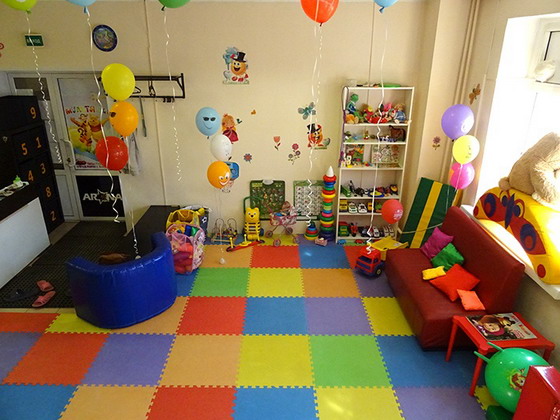
Themselves when buying, too, be guided by your list of suitable toys, made up with a "cold head", then you will certainly be able to avoid buying toys-one-day and unjustified spending.
Let in your house there will be enough good and favorite toys and even more joint fascinating games with children. After all, happiness and harmonious development of children is determined not by the number of games and toys, but by participation in children's games of moms and dads.
Tell
Storing toys in the children's room often turns into a problem: where to put them? How to make it so that the child can easily get them and then clean them up? So they do not pick up dust and fall under your feet? Therefore, the first thing to think about when arranging a children's room is a system for storing various games and toys.
Depending on what you need to clean, in the course are various ideas for storing toys. Soft toys, developing games and cars, of course, must be stored in different ways.
In a large nursery, of course, to accommodate roomy and convenient storage for everything necessary is much easier than in a small one. But even in a room of the most modest size it is possible to equip quite suitable structures for locating trains and dolls, designers and coloring books.
Options for storing toys
- Rack
A good idea for storing toys in a nursery is to build a shelving along the wall or as a partition between the functional zones, if space allows. In the lower part of the rack, special containers for toys are placed, these can be baskets, boxes or retractable containers. In the middle part you can place a TV, and in the upper part you can arrange cabinets for things that are rarely used.
- Baskets
Very nice option - the storage of toys in the child's room in wicker baskets. They can be put on the cabinet, if it is not high. If the child does not reach the top of the closet, this is not an excuse to refuse such design. In the basket you can remove those toys that he temporarily does not use.
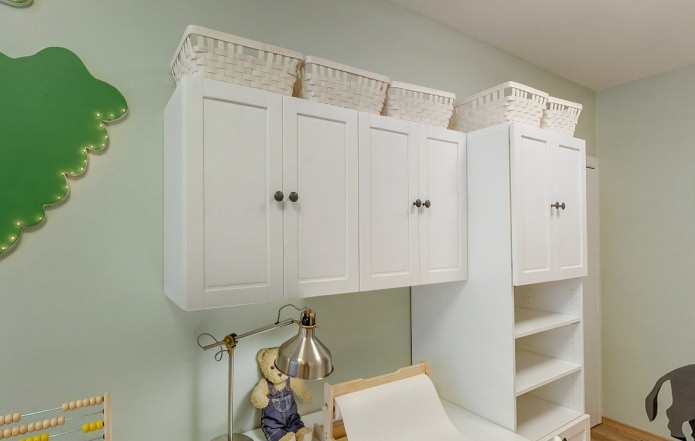
You can hang on the wall shelves and put on them baskets for the folding of toys. Such shelves, in addition to the main function, will also serve as a kind of decor for the nursery. An important plus: toys are always visible, they do not have to look. Minus - soft toys in this version will collect dust. Also, baskets can be placed in cabinets, on racks or left as separate elements.

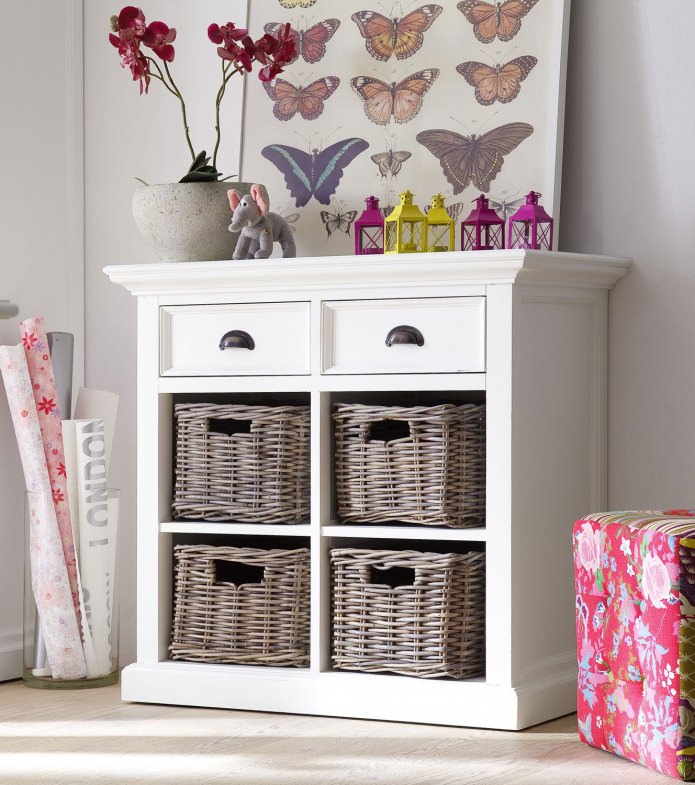
- Organizers
These storages are specially designed, and consist of two parts: a frame and containers that are inserted into it. You can purchase ready-made organizers, for example, in IKEA, or made to order. Frameworks can be wooden, metal, plastic, and containers, as a rule, are made of bright plastic, and look rather decorative. One of the main advantages of such a system is a low price.
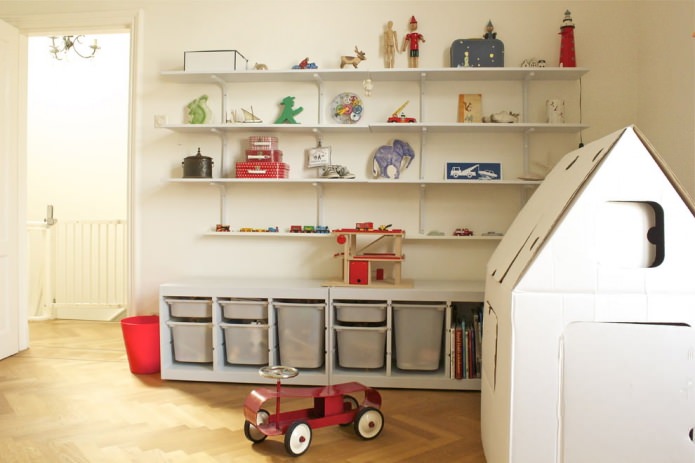
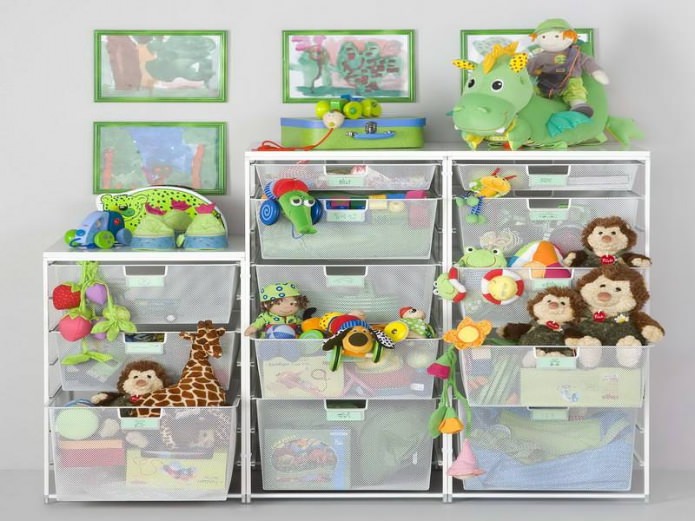
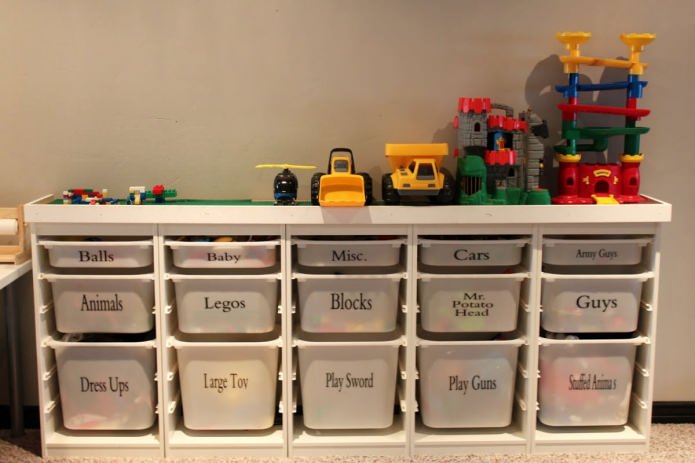
- Chests
Chests have been used since ancient times. It is convenient, and in case of use for storing toys in the children's room chests made of wood or leather, yet stylish. More budgetary option - plastic chests of different sizes. They can also be bright.
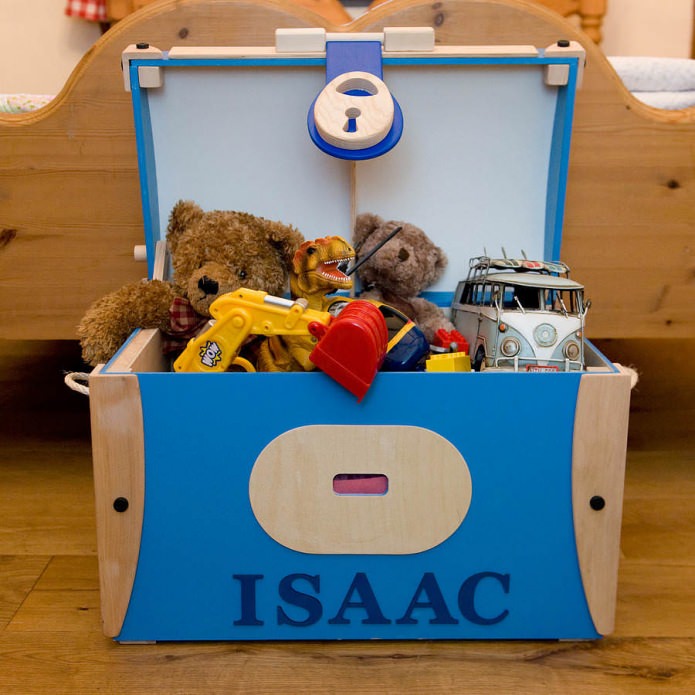
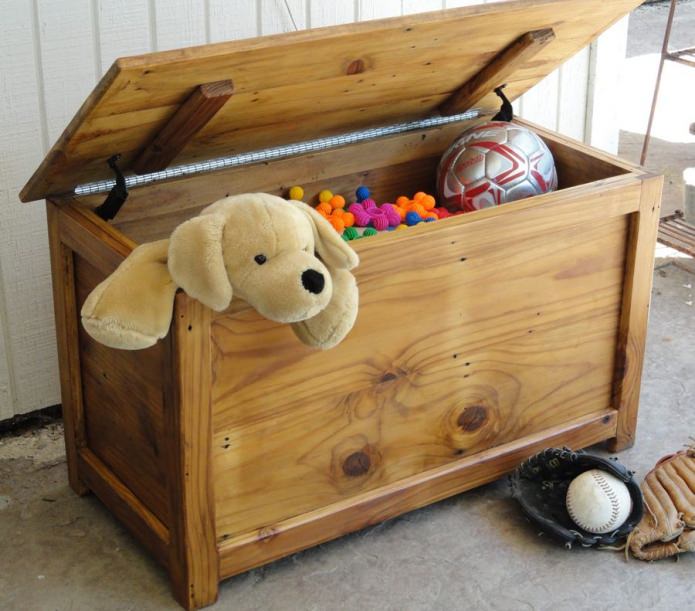
- Pockets
Among the ideas for storing toys the simplest is to sew wall pockets for them from dense fabric or even polyethylene. The size of such pockets can be any, depending on what is planned to be stored in them. Stitched from a beautiful fabric, they will decorate the interior.
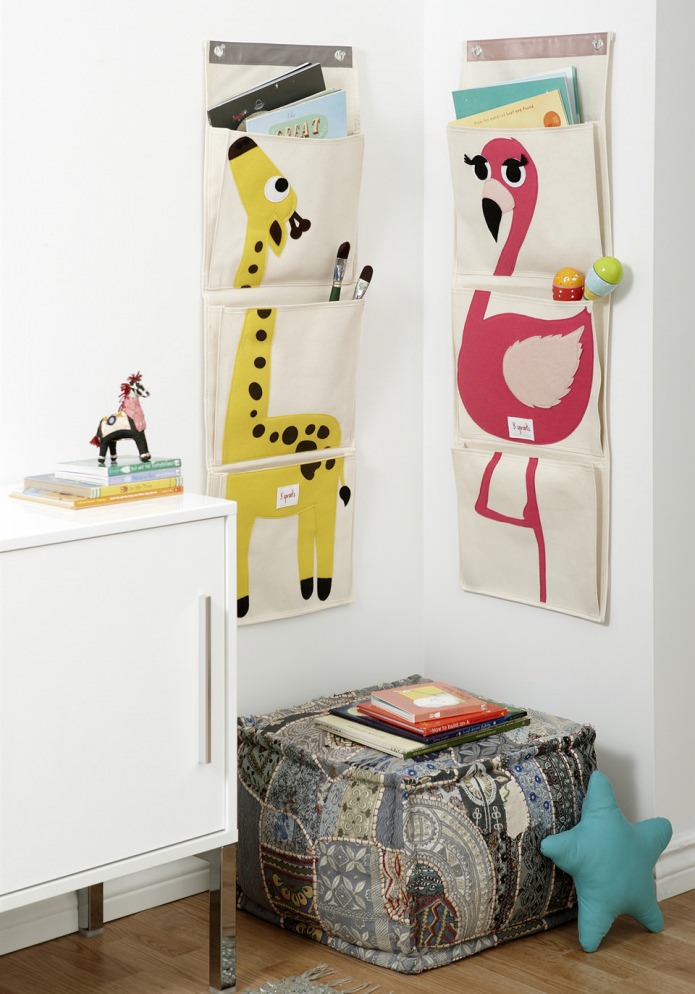
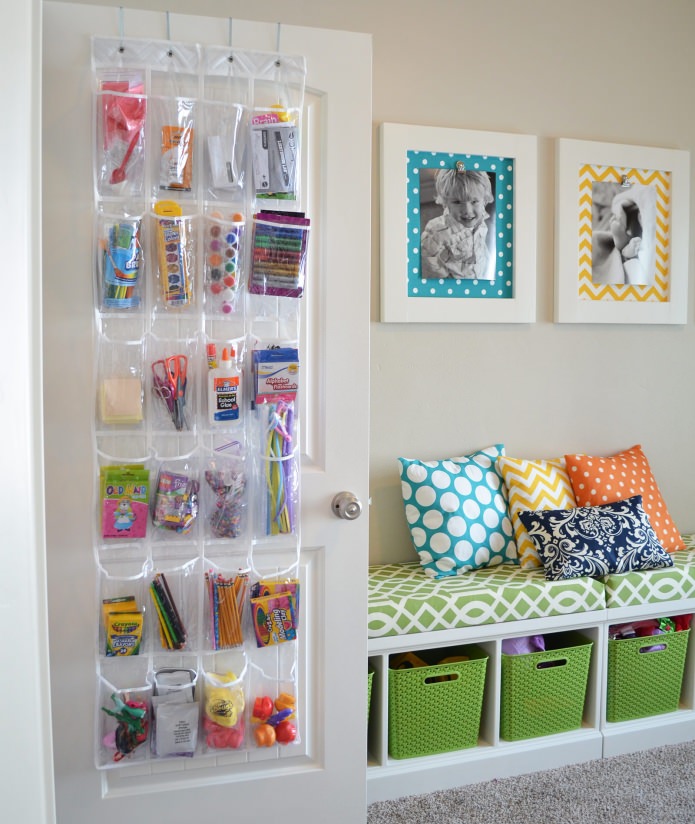
- Bed
The issue of storing toys can be solved with drawers placed under the bed. There are several options: either buy a ready-made bed equipped with such boxes, or make boxes under the order, and place under an already existing bed.
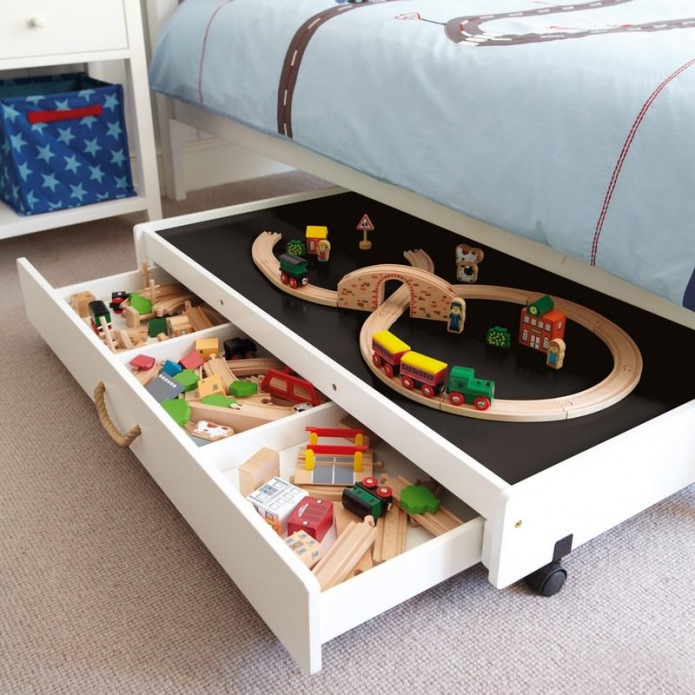
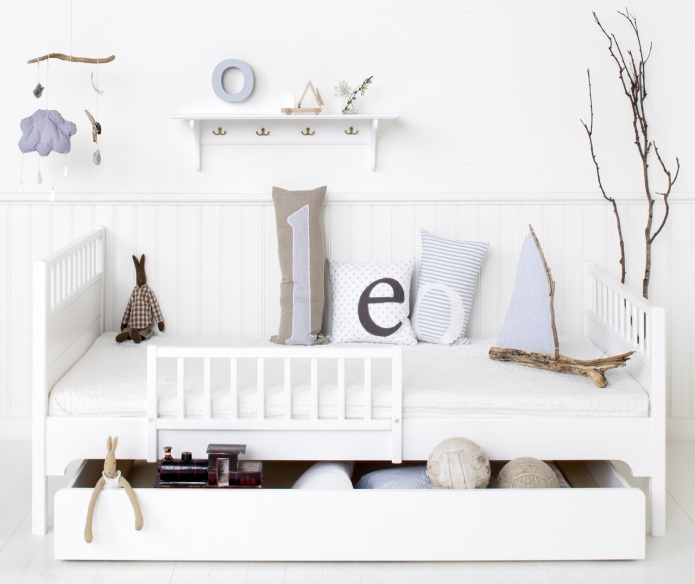
Many children like to sleep "on the second floor", climbing to the bed on the stairs. In this case, in the lower tier you can arrange a workplace for the child, and surround it with lockers for storing toys. Such beds "in the attic" are very attractive for children of different ages.

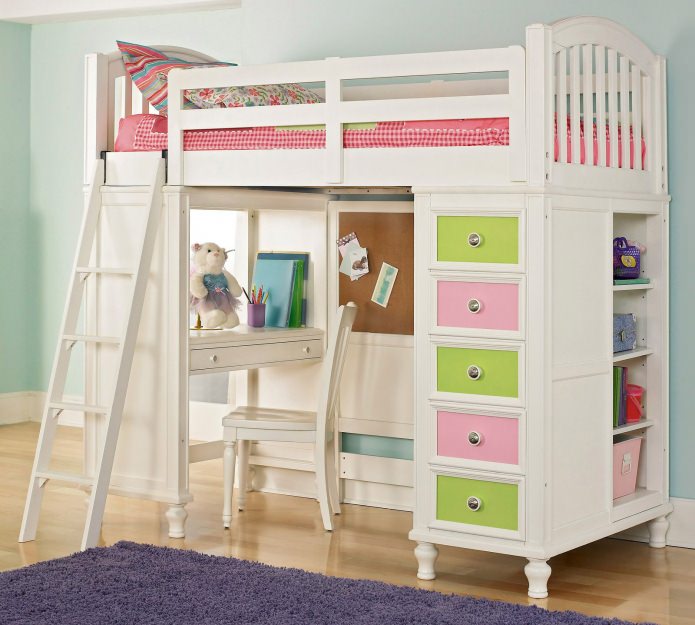
- Bench
Storage systems for toys in the child's room can be combined with other items, especially in a small nursery. If you equip a bench under the window, under which to place boxes - either pull-out, on wheels, or sliding on the guides - you will get a very cozy place to relax and at the same time - a place where it is convenient to clean toys and where it is easy to get them.
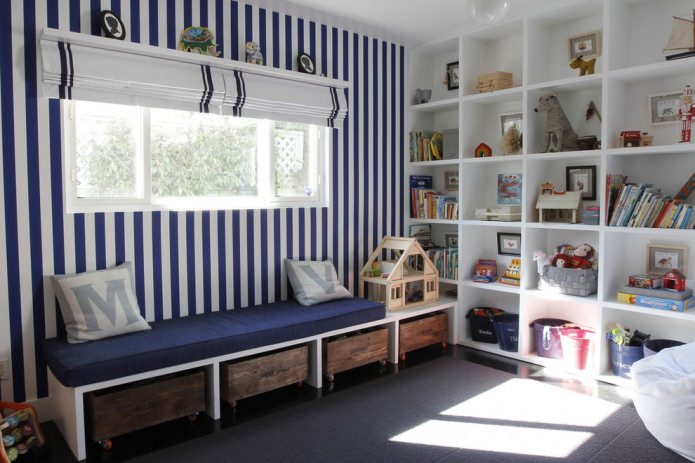
![]()
- Boxes on wheels
Another interesting idea. All that is needed is a box of wood, wheels from rollers, skateboard or old furniture. With the help of such a box for storing the child it will be convenient to transport the toys of their one room to another.
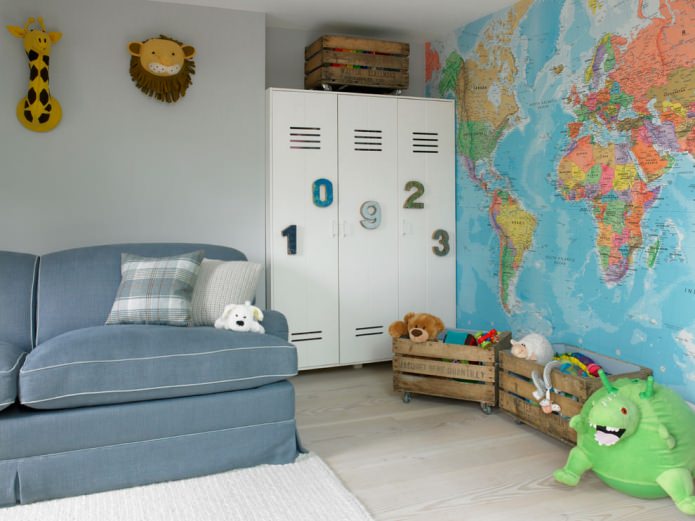
Rules for storing toys in the children's room
Whichever way to place toys in the room you have not chosen, it is worth keeping to the rules, common devices of all storage systems.
- The optimal option - the placement of toys in separate containers, so it's easier to clean up, easier to clean.
- Storage of toys in the child's room should be thought of so that it can easily be removed and removed, too high located storage will be inaccessible to him.
- If the containers with toys are located at the bottom of the rack or cabinet, it must be properly fixed, screwed to either the wall or the floor, so that heavy furniture does not fall on the child.
- The main requirement for the material from which the containers are made is the ability to easily wash them. From time to time, this procedure must be carried out to remove accumulating dust and dirt.
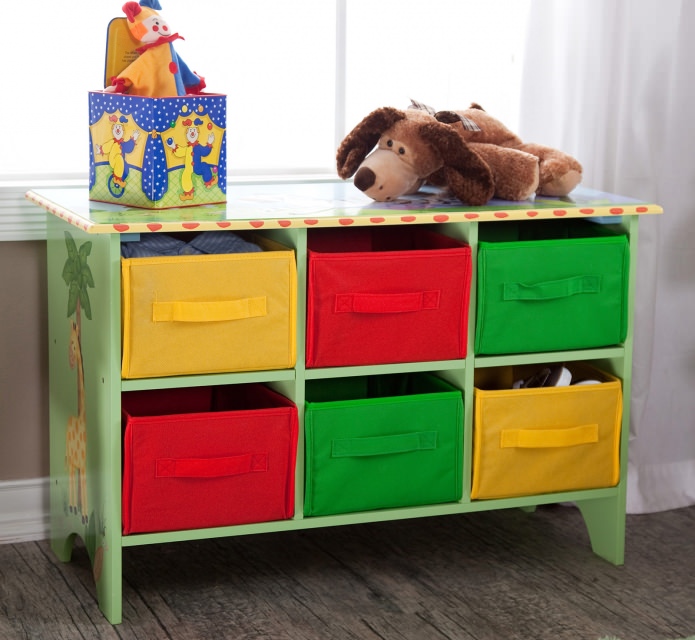

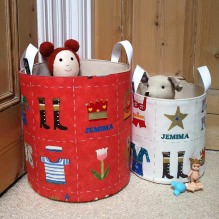

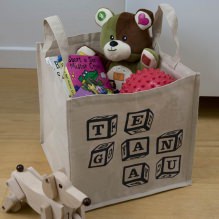

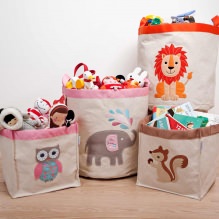
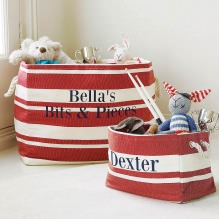
When there is a child in the house, it is very important to use the living space intelligently so that there is a place for active games. And it's good when toys, books and much more are always in the same place, so that you can easily find. It is best for this purpose suitable special shelves for toys, which you can build yourself, pre-preparing the drawing.
Solution Advantages
After the construction dries, it is processed and then covered with paint or varnish. Then the shelves for toys when mounted on the right place are fastened to the wall. When installing the shelves, fix the corner clamps to ensure the right angles and strength of the structure.
Installation of baguettes or other framing
To begin with, cut off part of it to decorate the top edge of the structure with a hacksaw and shake the ends at an angle of 45 degrees. In order not to translate material, strictly observe the dimensions. Put on the rebate adhesive composition, then put the baguette and press the clamps. Similarly install the rest of its parts, at the end, fix the corner joints.
However, remember that our shelving for toys, respectively, decorate them can be more interesting. For example, boxes will look more fun, if you hang them self-adhesive Another option - to install sheets of different colors, or to cover the surface with a film of a particular shade, or with the image of animated or fairy-tale heroes.
To fix the edge, attach it with the adhesive side to the end part of the structure and heat it by means of an iron. Then iron it with a rag until it sticks tight to the surface, scrape off excess edges with sandpaper or with a blunt knife.
Installing boxes
To equip them with a design, there is nothing complicated, the main thing is to correctly calculate their dimensions. A rack for toys with boxes is just as easy to assemble as a normal one. For their basis, we need a chipboard, the plates should have a thickness of about 16 mm. But as the bottom is recommended to use hardboard, which either cuts into the walls, or is nailed to them through nails.
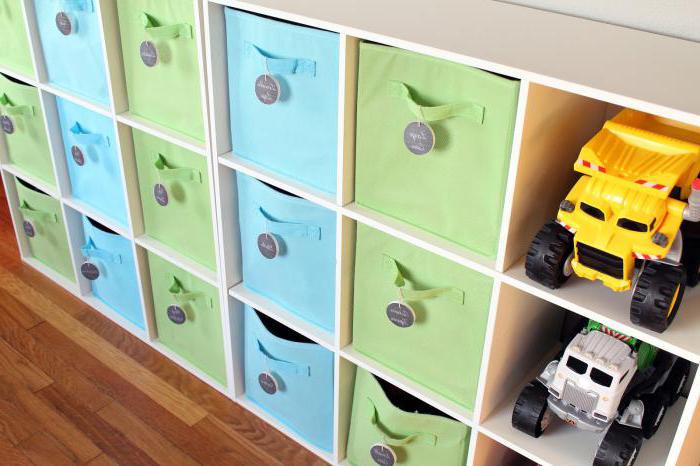 In order for the boxes to move freely out of their cells, it is advisable to buy special furniture rollers. In addition, they will serve as additional fasteners for the bottom of the structure.
In order for the boxes to move freely out of their cells, it is advisable to buy special furniture rollers. In addition, they will serve as additional fasteners for the bottom of the structure.
The facade of the box can be made of both colored chipboard and finished designs of the right size.
Also, in addition to this and the rollers, prepare the screws for their fastening, the hinges for the slabs and the confirmations - screeds.
Our toy shelf, constructed by our own hands, is almost ready.
The final stage of work
In the end, it will be necessary to drill the holes on the structure under the fastening fixture, and then finish:
- zashpatlyuyte all holes;
- clean the adhesive if it protrudes in the joints;
- cover the structure with a protective compound, more often a lacquer is used for this purpose.
To drill a hole correctly, mark its center with a core, and then do the work with a drill with the correct diameter. In the received slot we insert markers for dowels, which will help to mark the place for drilling under the second part. So will coincide the holes when assembling the structure. The dowels are inserted when the fastening points are made on both parts.
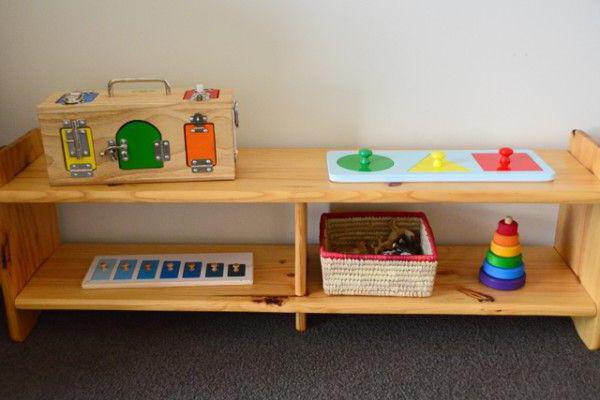 We have considered how to make a wooden toy rack, now let's find out how this work can be done using other materials.
We have considered how to make a wooden toy rack, now let's find out how this work can be done using other materials.
Assembling gypsum board products
Shelving for toys based on this material is not so difficult. The design will last long enough. Before work, do not forget to make it a sketch and calculate the necessary amount of material for work. Typically, the dimensions are: a gypsum plasterboard sheet about 1.2 m wide and 2 to 4.5 m long. Its thickness is 6-24 mm.
If in addition to toys and other children's accessories you plan to put a television set or something in the rack, then instead of the usual profile it is recommended to purchase a corner made of metal.
For a framework, a conventional UD profile is suitable. Attach the base rails to the floor and wall using self-tapping screws and from them erect vertical sidewalls, horizontal shelves and intermediate piers. The frame in the process of installation must be constantly checked for flatness horizontally and vertically with the help of the spirit level.
When it is ready, take the metal screws with a size of 25 mm and fasten the upper and lower shelves with them. Then the frame is covered with fine plasterboard steps. You can use all sorts of rounding and smooth transitions, not limited to straight angles and lines.
Putty plasterboard shelving
First, clean the surface of dust and dirt, then treat the screwing points of the screws with a special primer. After that, we paste the reinforcing mesh on the seams and butt joints. Do not forget to prime them too.
Angles and slopes are equipped with a metal or plastic corner. If the shelves are figured or arched, then choose a product with a curving structure. Apply on the corner putty on both sides with the same even layer and squeeze as tightly as possible. If its part came out through perforation, remove it with a staple and level the surface.
When the first starting layer of putty dries, apply a second, it's the final one. Try not to damage the finish surface. For this purpose, leave the edge of the working edge on the spatula clean and even.
After the last layer has hardened, all surfaces are ground with a special grater equipped with a replaceable abrasive mesh, then we spread them with a primer and cover with water-based paint.
It is highly desirable that the shelves for toys in the children's room are in harmony with other furniture.
Homemade for toys
 On the technology of manufacturing of this type of construction it is worthwhile to dwell separately. If you want to make an angular toy rack for the children's room, then prepare the following for work:
On the technology of manufacturing of this type of construction it is worthwhile to dwell separately. If you want to make an angular toy rack for the children's room, then prepare the following for work:
- wood chipboard, equipped with maple veneer;
- screws with a syringe in the form of a cross;
- a maple patch with a width of about 20 mm;
- flat guides in an amount of 2 pieces;
- wood glue;
- sandpaper;
- drill with a drill for wood;
- iron;
- hacksaw.
Stages of work on assembling the structure
First of all, it will be necessary to cut out the bottom and top wall from the chip-saw, then - five shelves, and then the connecting structures in the number of four pieces. Every detail must have its own size. After that, we clean the edges with sandpaper and glue the maple patches on the ribs by means of an iron. Remove the excess edges and connect the place of gluing the parts with screws.
 Drill three holes along the lower and upper edges. Then the details of the construction are glued and fastened with the same screws. The shelving is recommended to be assembled starting from the bottom shelves and walls, since the upper part and the ribs at the bottom should be located in the same plane.
Drill three holes along the lower and upper edges. Then the details of the construction are glued and fastened with the same screws. The shelving is recommended to be assembled starting from the bottom shelves and walls, since the upper part and the ribs at the bottom should be located in the same plane.
The next stage of work is gluing and screwing to the tender shelf of the connecting wall along the short edge. And to its upper edge we mount the second one. Then we perform similar actions in the same sequence. In the end, the upper shelf is attached to the rack.
Other ways of storing toys
Naturally, far from everything parents can always make shelves for toys with their own hands or buy them. Sometimes the issue in finance, also the reason may be a small room or lack of time. Therefore as alternative and simple ways to arrange a place for toys it is possible to result such:
- arrangement in the room of plastic boxes (sometimes they can be attached to the wall);
- installation of metal hanging baskets;
- net designs from garden shops;
- automobile painted tires can also become a place for storing toys;
- wooden vintage boxes;
- plastic buckets connected with each other by crosspieces.
Well, if you and your child want something more simple and less original, and a place in the room allows, it is better to buy a wardrobe for toys, where everything can fit.
There are a lot of ideas about this, however, it will be very interesting for the parents to make a shelf for children's toys by their own hands, you can connect the children to the process.
The children's room, as a rule, does not involve a large space, because in the souls of caring parents their child will always remain a baby, even when the "baby" begins to hit the top of the doorway with his forehead. Meanwhile, the number of toys and various small things continues to grow as the child grows up and sometimes takes on a horrifying scale. Of course, many live well in the chaos of the surrounding things and feel at the same time quite comfortable. But what do the owners of studio apartments have in which the children's room has an improvised look? So, toys constantly wander from the nursery to the living room-bedroom and back ... In this article we will tell you how to store toys in the nursery in such a way that it suits you and your child.
1. Shelf with multiple shelves
This option is unusually functional and can be used not only for storing toys, but also for zoning space. The rack allows you to separate the children's room or organize a special play area in a large room.
If the shelves on the rack are roomy, you can place there are not items themselves, but plastic boxes or baskets filled with toys. They are also desirable to sign: in this way you place the toys in categories and they will not be lost.
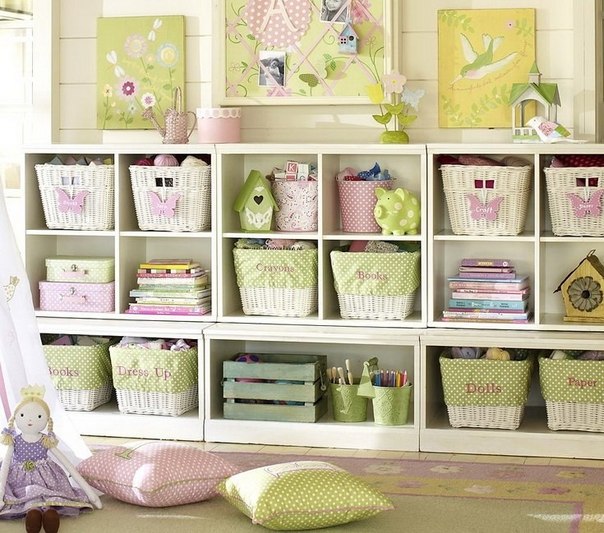
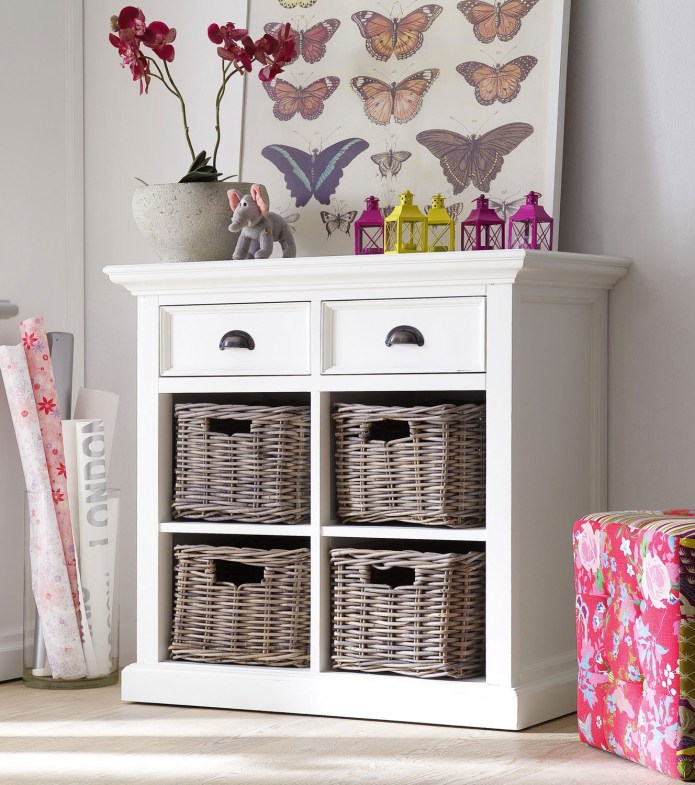

As the child grows up, such a rack can easily be upgraded to a store for books or cosmetics. You can even not change the basket, but just re-write the inscriptions.
2. Bed-chest of drawers
The perfect solution for a small child will be a bed-chest of drawers. It is also ideal for those children who like to sleep in embrace with all their plush "kingdom" or those who play without getting out of bed.
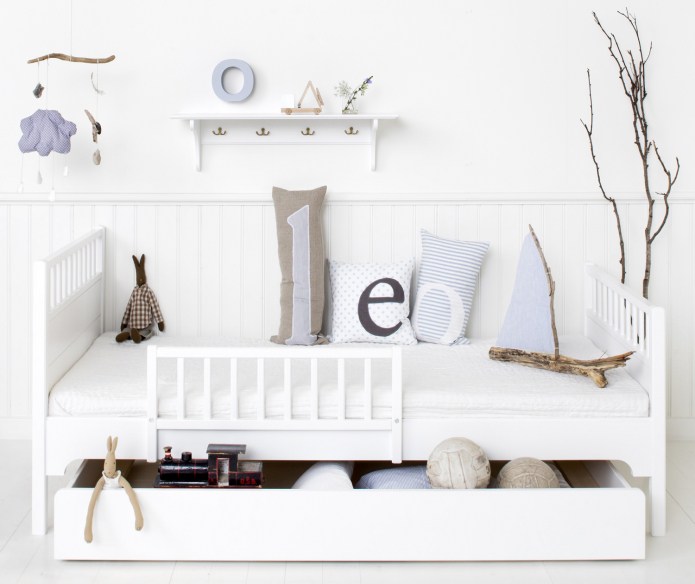
Such a bed can be equipped with a drawer or simply have open shelves, which can be additionally equipped with baskets for greater roominess. If you do not like this type of bed, you can make a small sofa-chest or decorate in this style the space next to the window: save space and create a fun corner for recreation and games.
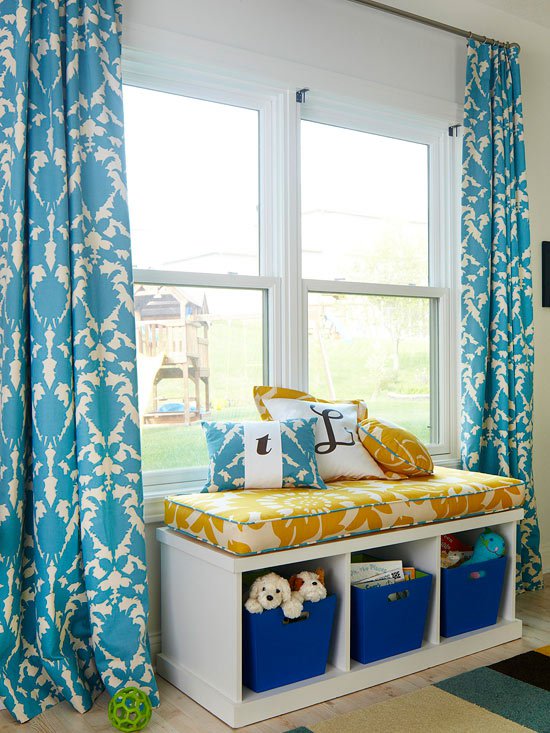
![]()
3. Chest
Who in childhood did not dream of a large-large chest, where you could hide not only toys, but also hide yourself? This is a great place to store all the children's treasures, in addition, it can simultaneously be used as a chair or table.
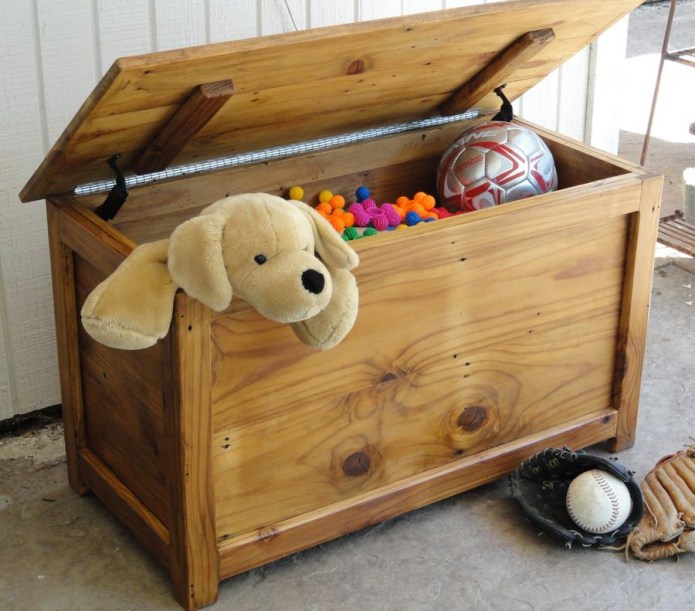
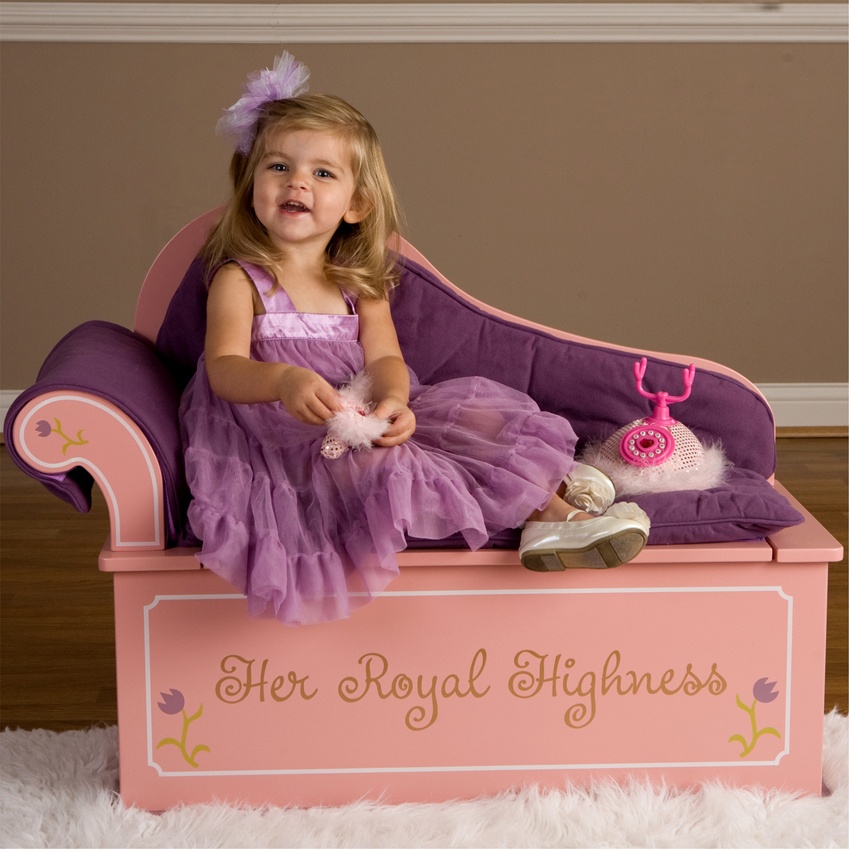
Well, let's be honest - What child likes to clean and lay out toys? Here, this problem is solved simply: you just need to grab all the toys in an armful, put them in a chest in one big heap and sit proudly from above. The main thing is to make sure that the number of items corresponds to the size of the chest. In terms of design and material, the chest can be very different, from laconic wooden models to stylized furniture or a favorite cartoon character. We recommend that you first of all pay attention to roominess.

4. Pockets
Textile pockets will be an excellent option for storing small items and also take up very little space. They can be placed almost anywhere, from the walls to the bed.
Toys, especially interesting and useful, do not happen much. Perhaps most parents agree with this. But where to store numerous cars, houses, cubes, balls, designers? How to find a place for dolls and soft animals? The toy storage system is one of the most important components of the children's room. Without it, not do. Do not worry if the child's room is modest in size - there are a number of practical solutions for the smallest rooms. If the room is large - even easier. Here you can equip full and very convenient storage without compromising other important areas.
Storage of toys in the children's room: important nuances
1. It is best to store toys in boxes or containers. With such a storage system, the order is quickly and easily set up. If you put toys on the shelves, cleaning will take too long.
2. Toys should be stored at such a height that the child always had access to them. If the rack is low. If the wall cabinets, then close to the floor.
3. Heavy furniture, in which the toys are stored, it is necessary to fix, attaching to the wall, even if it is a very small rack or curbstone. Security is above all.
4. The containers in which the toys are stored should be easy to wash. Periodically they need to be rinsed or wiped.
How to store toys in the nursery?
1. Bench with drawers. Most often it is located under the window. The design is stationary and is mounted on site. From above it is desirable to put soft mattresses.
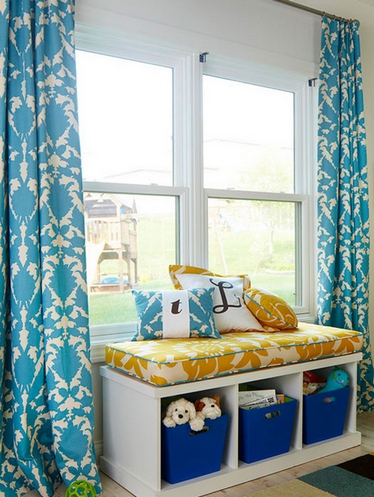
Containers are inserted into the niche under the seat. Before you order the manufacture and installation of such a structure, you need to choose containers to know exactly their size and quantity. As a result, the room is replenished immediately and a repository of toys, and a corner for reading, and a place for the reception of guests.

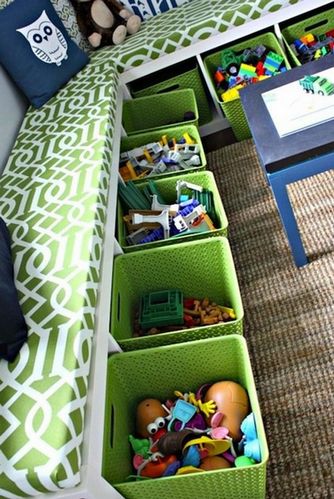
2. Low rack. Part of the cells of the rack can be taken under the containers with toys, and some - under the books and office. The space above the rack will not vanish in vain if hung, a projection screen or training posters.

Shelving bench
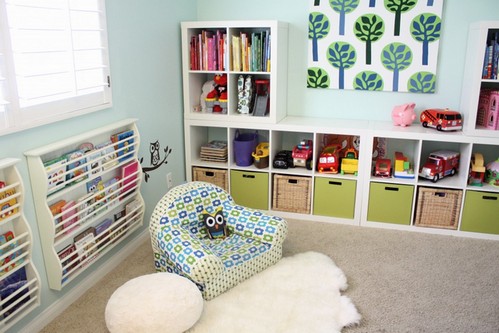

3. Bed with drawers. This is a very practical solution for a small child. In the shops there are standard beds with roll-out and drawers. If existing samples do not suit, you can order a unique model. For example, a bed-platform with a niche for containers or a loft bed with a shelter under a bed.
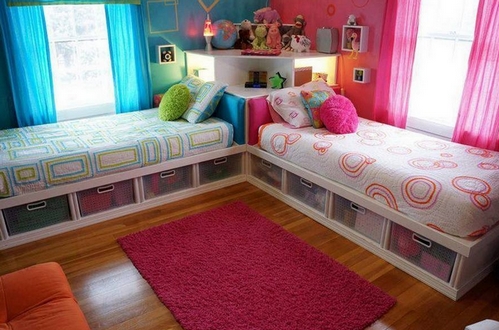
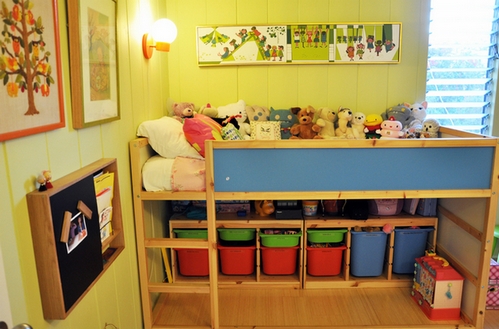

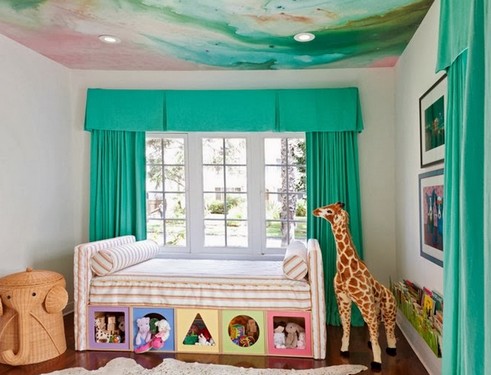

Warehouse under a bed: a good idea for storing toys in a small room
4. Wall baskets. This option is especially good if the room has an empty boring wall. Baskets with toys fill the void, making the interior more fun. Children like this decision because the contents of the baskets are always in sight. Do not need to dig for a long time in different containers in search of the desired toy.
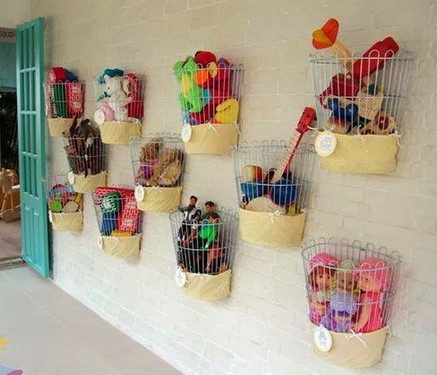

5. Suspended storage systems: sachets and soft shelves. These products are made of non-woven fabric, polyethylene, mesh, etc. Such elements are very practical, because they can be placed in areas that are not available for other options. For example, a sachet (a system with pockets) is often hung on the door, and hanging shelves are fixed on the bar of the wardrobe. Minimum space is the maximum benefit.
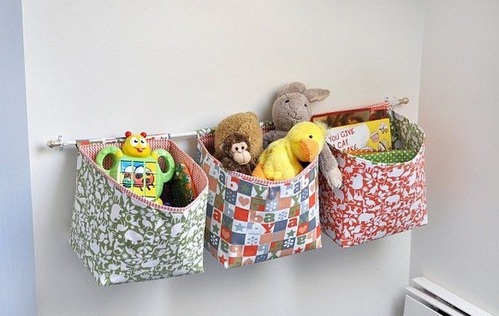
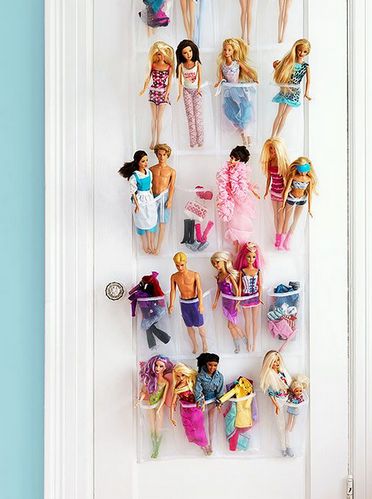
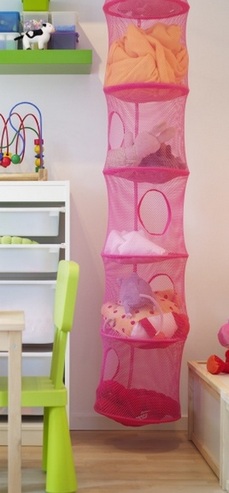
6. Organizers-combinations. These are special interior items designed specifically for storing toys. They consist of a frame and a filling. For example, in shops IKEA the buyer independently makes a filling, selecting containers of a suitable color. The organizer frame can be made of MDF, wood or plastic. Containers are usually plastic. The advantages of such a toy storage system are low cost and brightness.
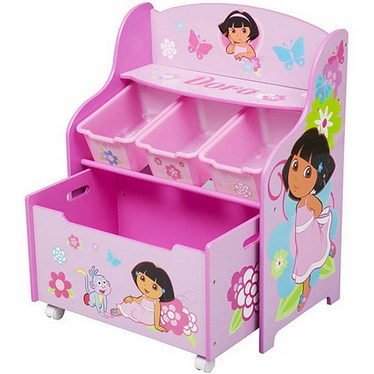
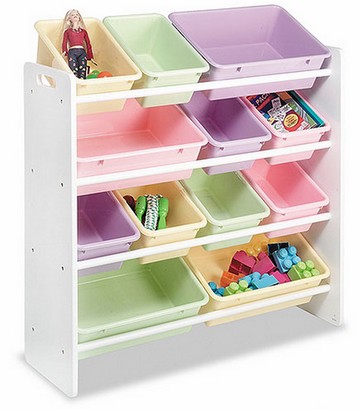
Organizers for storing toys
7. Chest. Yes, an old good chest in which the kid will keep his treasures. Chest can be wooden (perhaps even carved or painted), woven, plastic. On sale you can find light and very bright products made of plastic.
